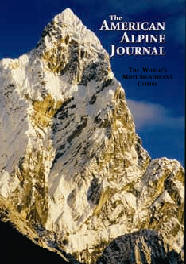 | |
| Categories | Climbing, mountaineering |
|---|---|
| Frequency | Annual |
| Publisher | American Alpine Club |
| First issue | 1929 |
| Country | United States |
| Based in | Golden, Colorado |
| Website | Journal Homepage |
| ISSN | 0065-6925 |
The American Alpine Journal is an annual magazine published by the American Alpine Club. Its mission is "to document and communicate mountain exploration." [1] The headquarters is in Golden, Colorado. [2]
Contents
Subtitled as a compilation of "The World's Most Significant Climbs," the magazine contains feature stories about notable new routes and ascents, written by the climbers, as well as a large "Climbs and Expeditions" section containing short notes by climbers about new and noteworthy achievements. Some general articles about mountaineering, mountain medicine, the mountain environment, or other topics are also sometimes included. Each issue includes book reviews, memorials of deceased members, and club activities.